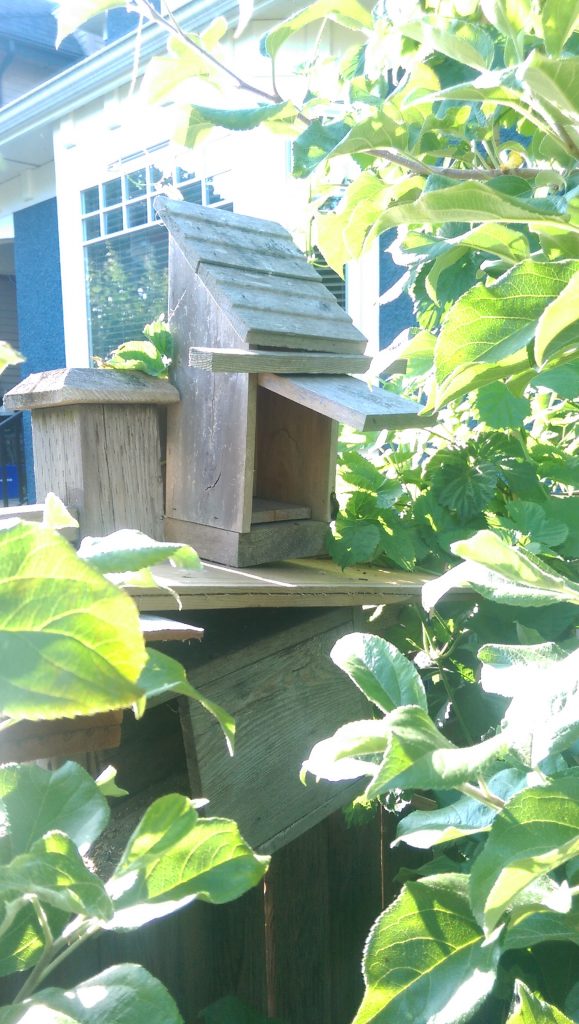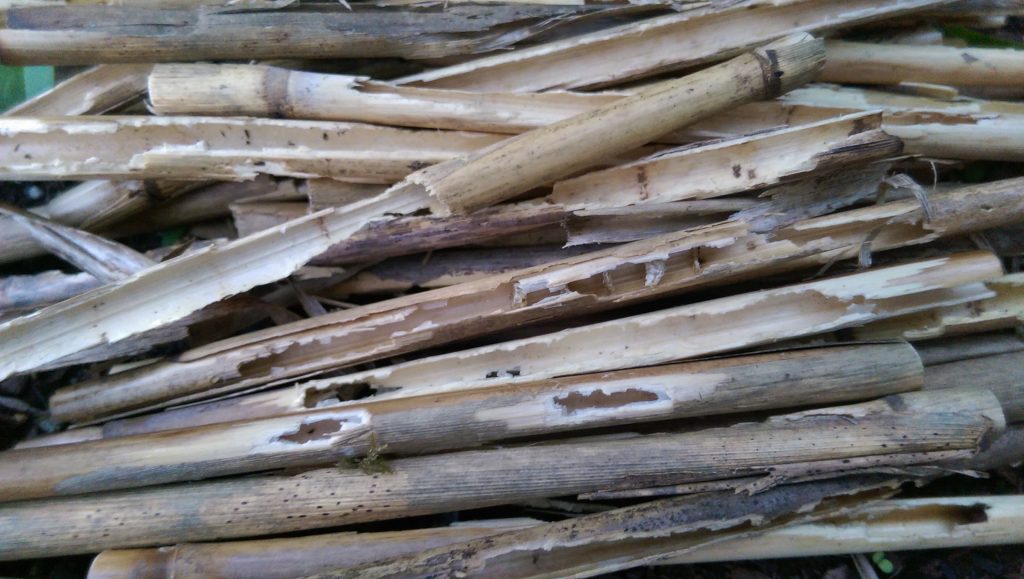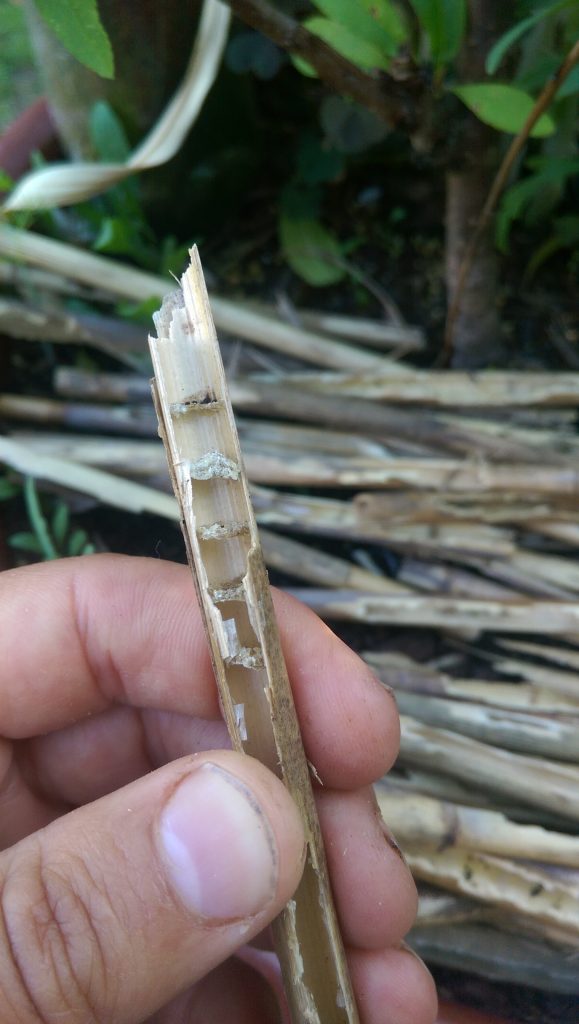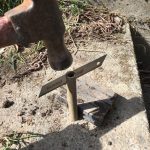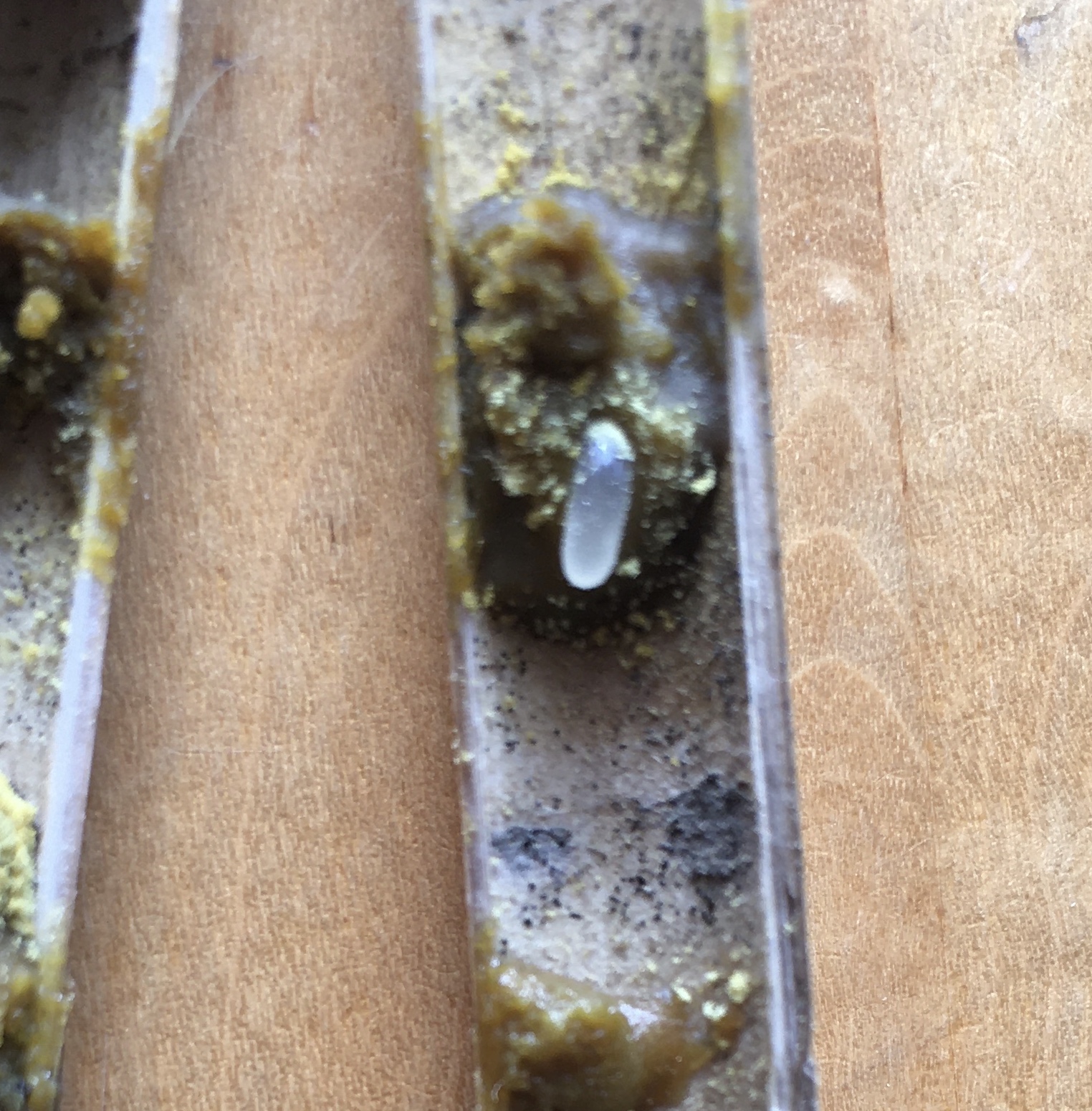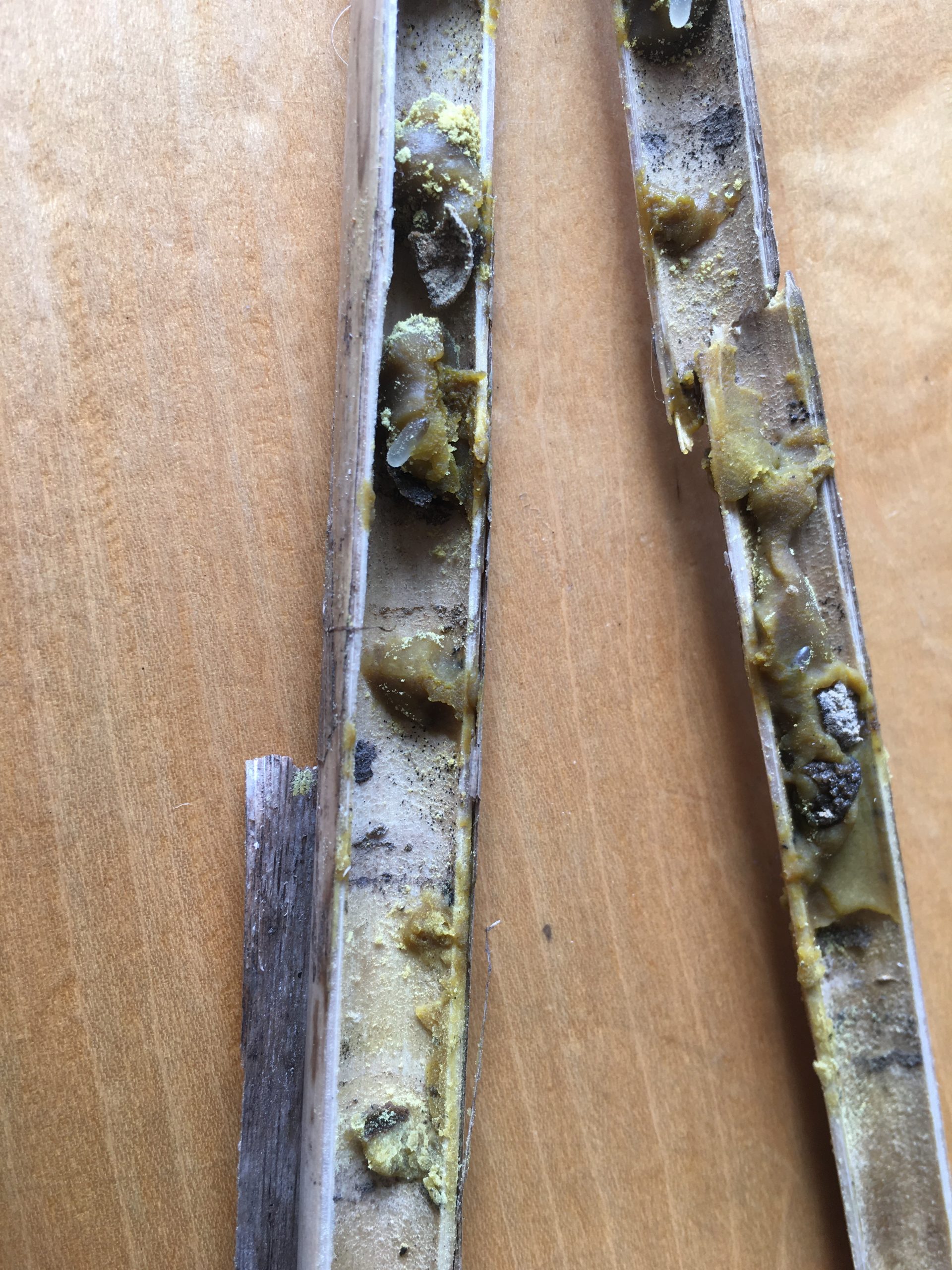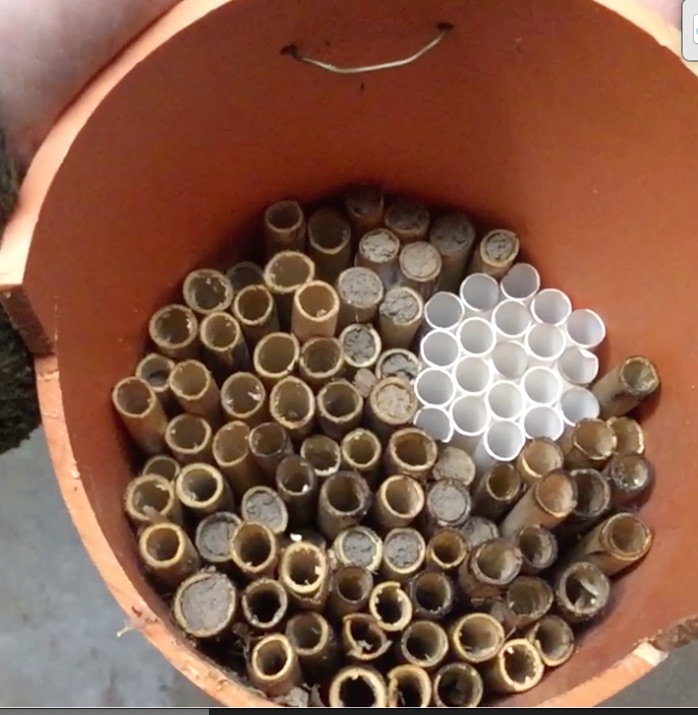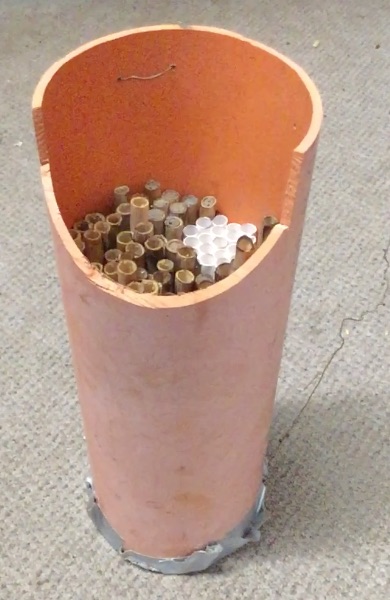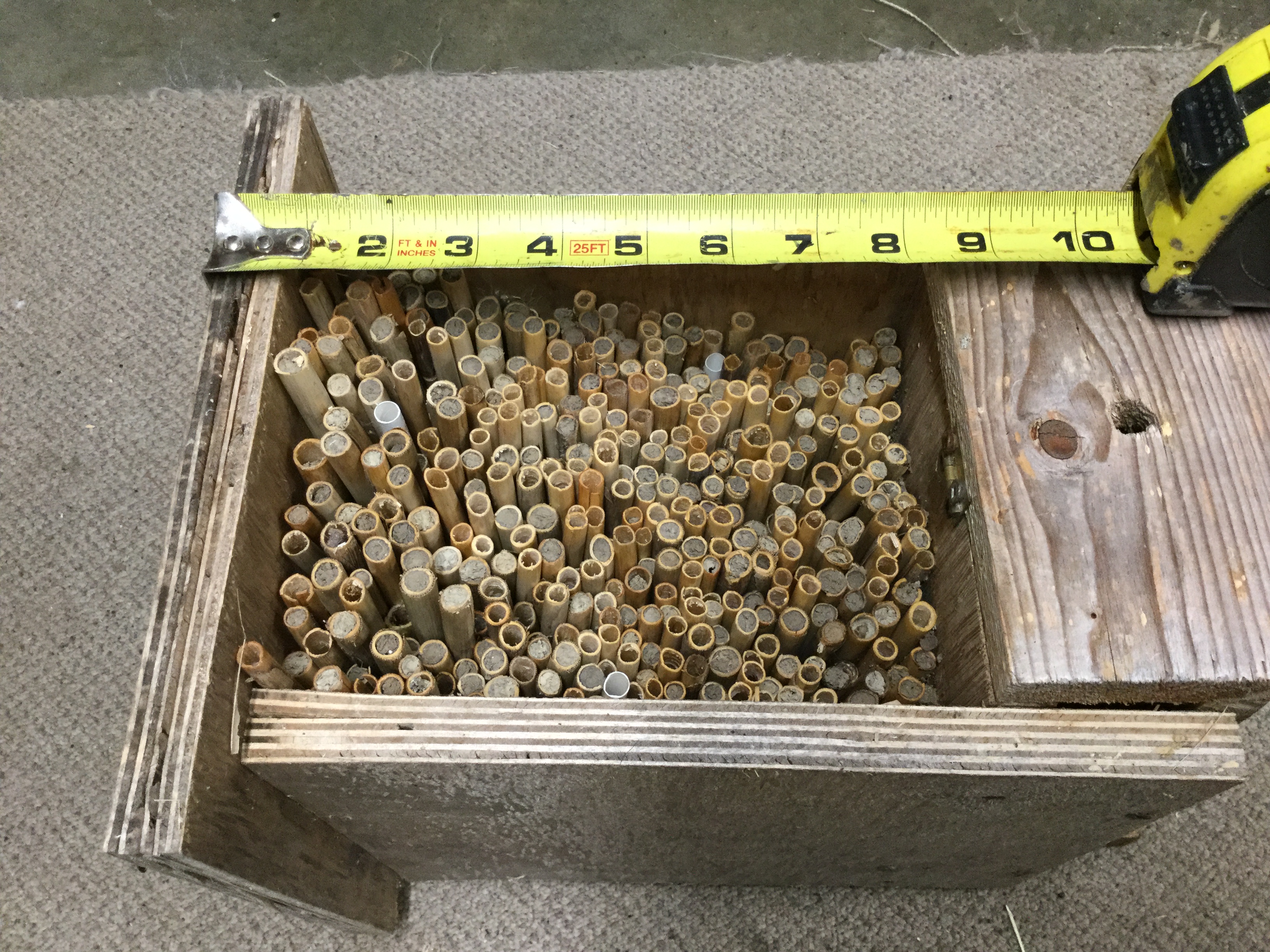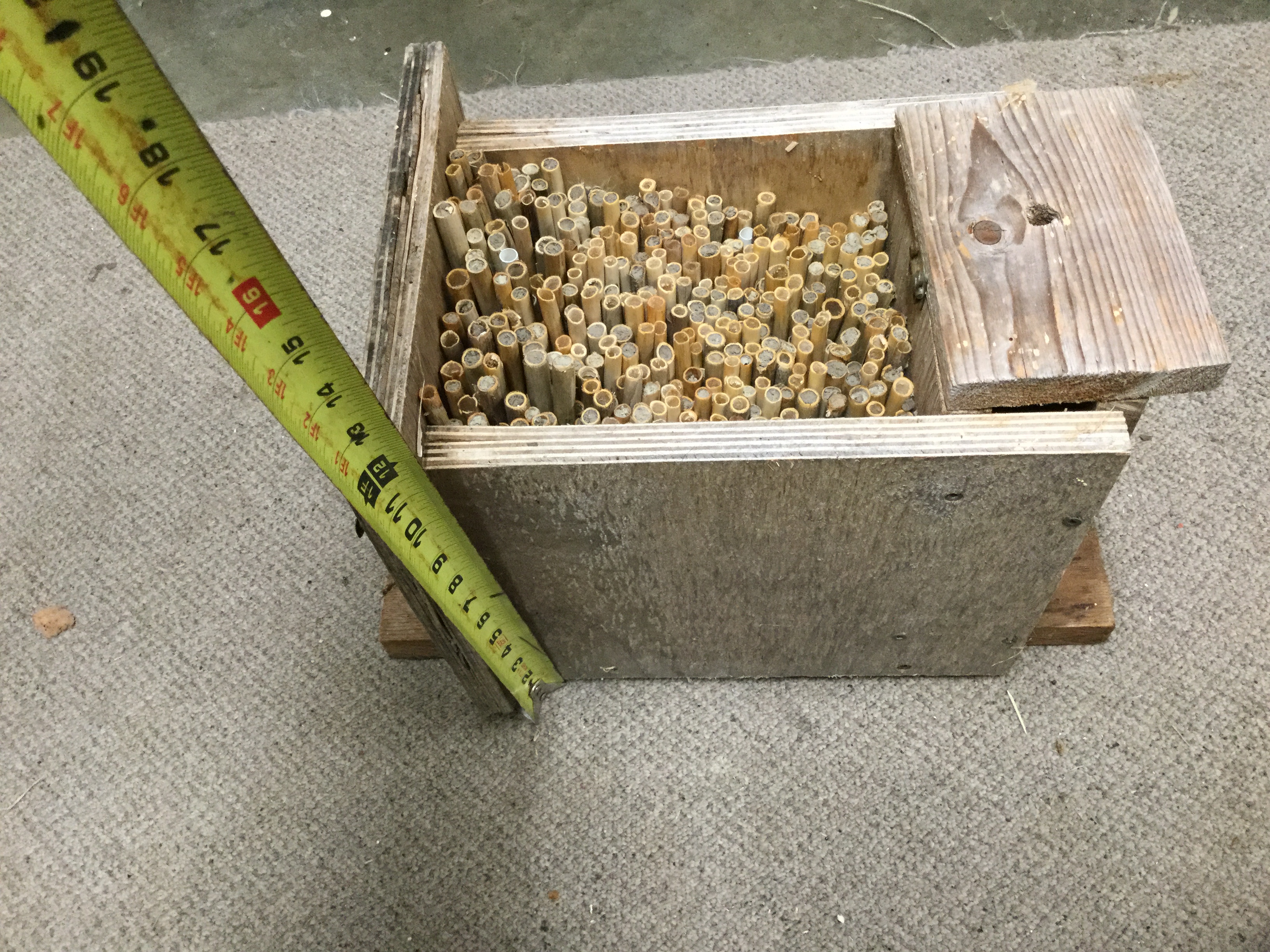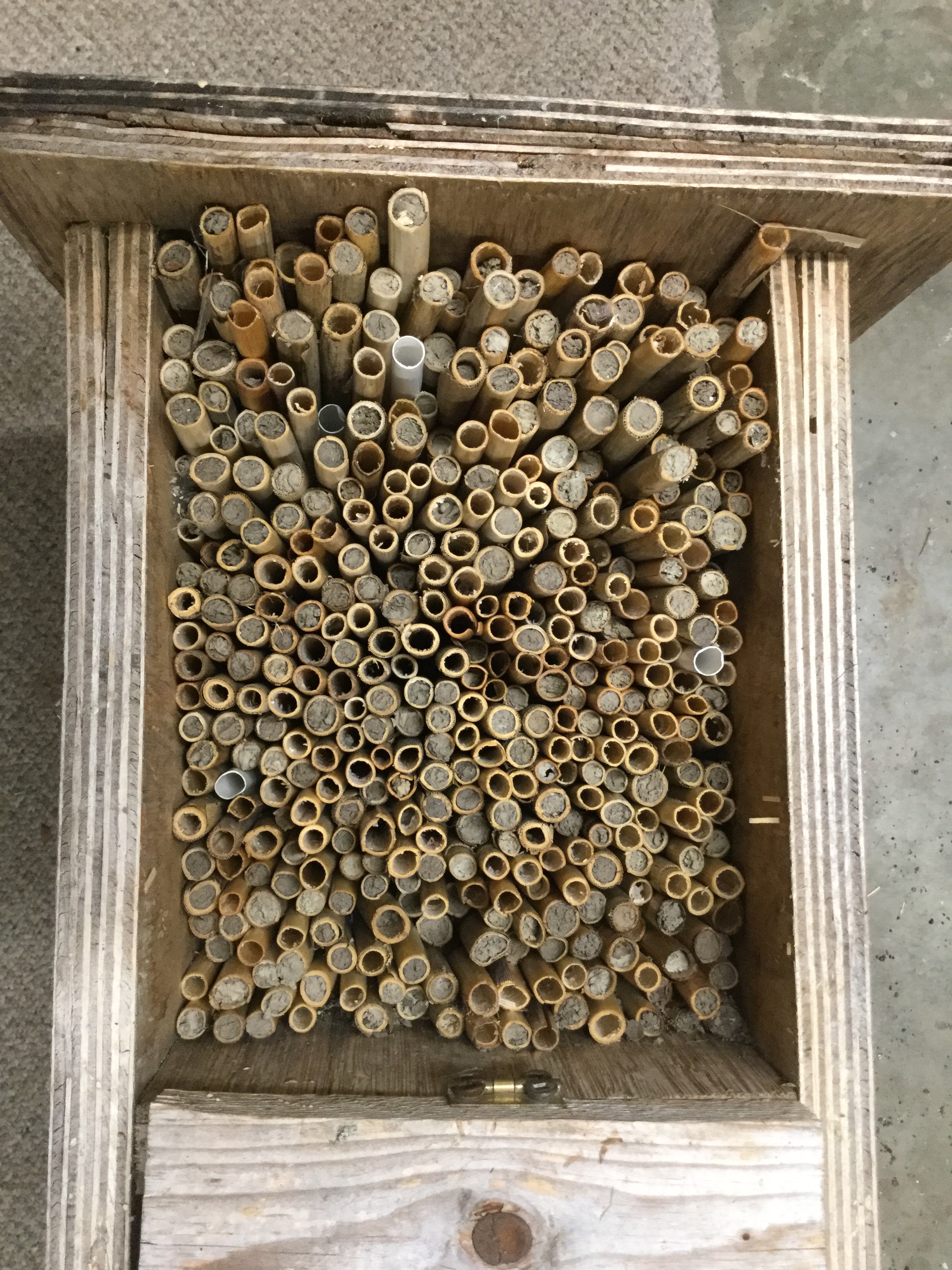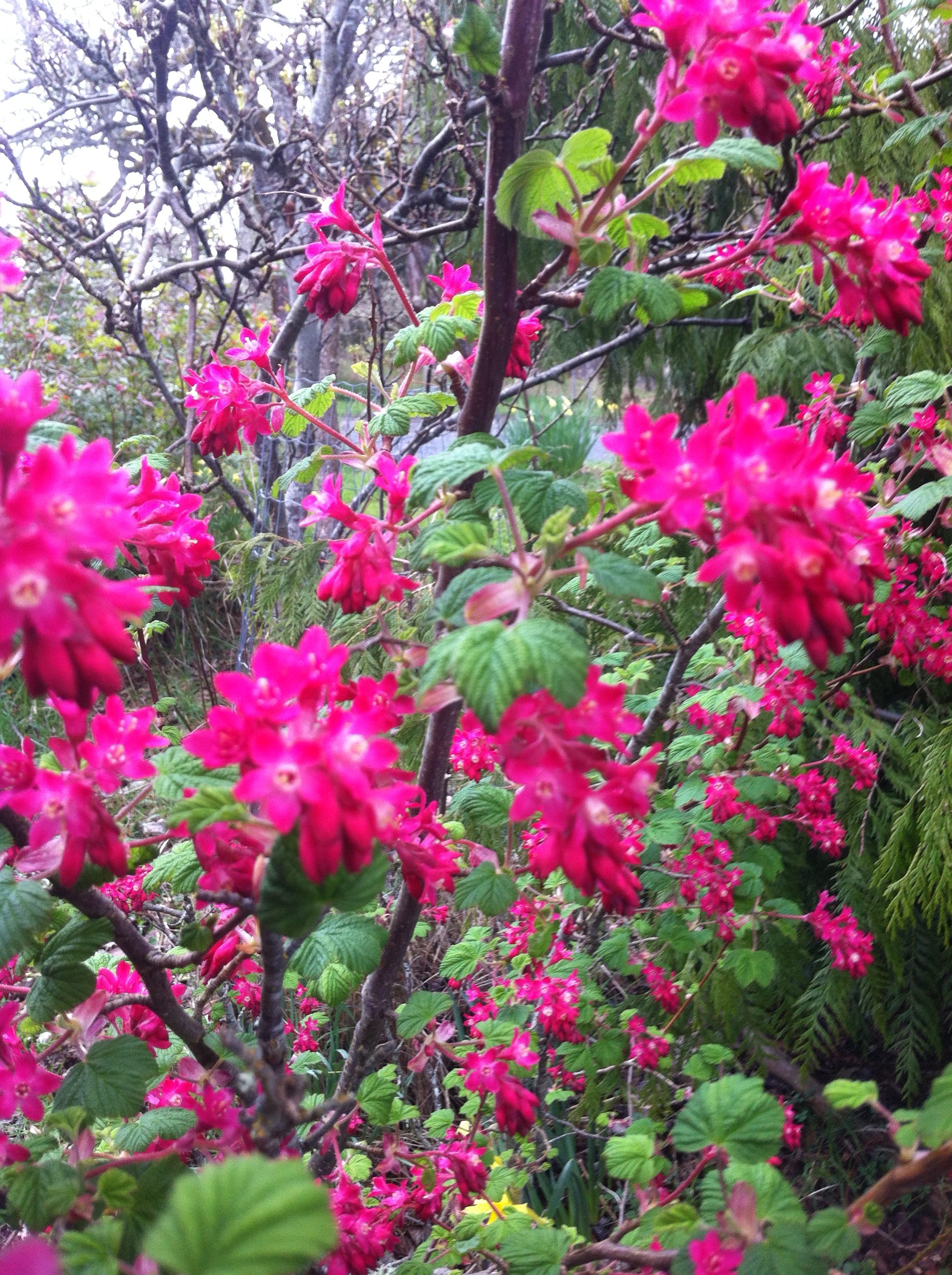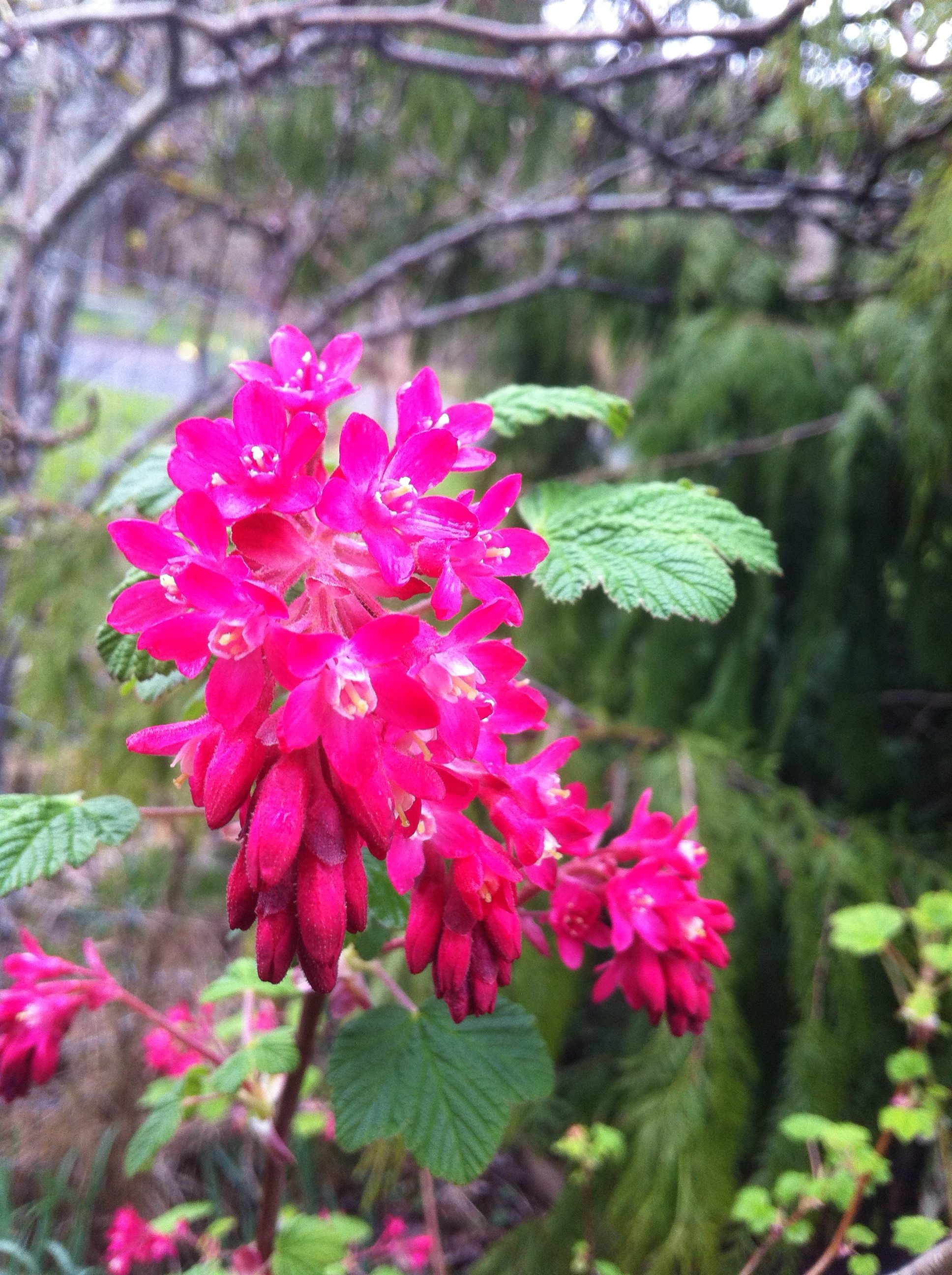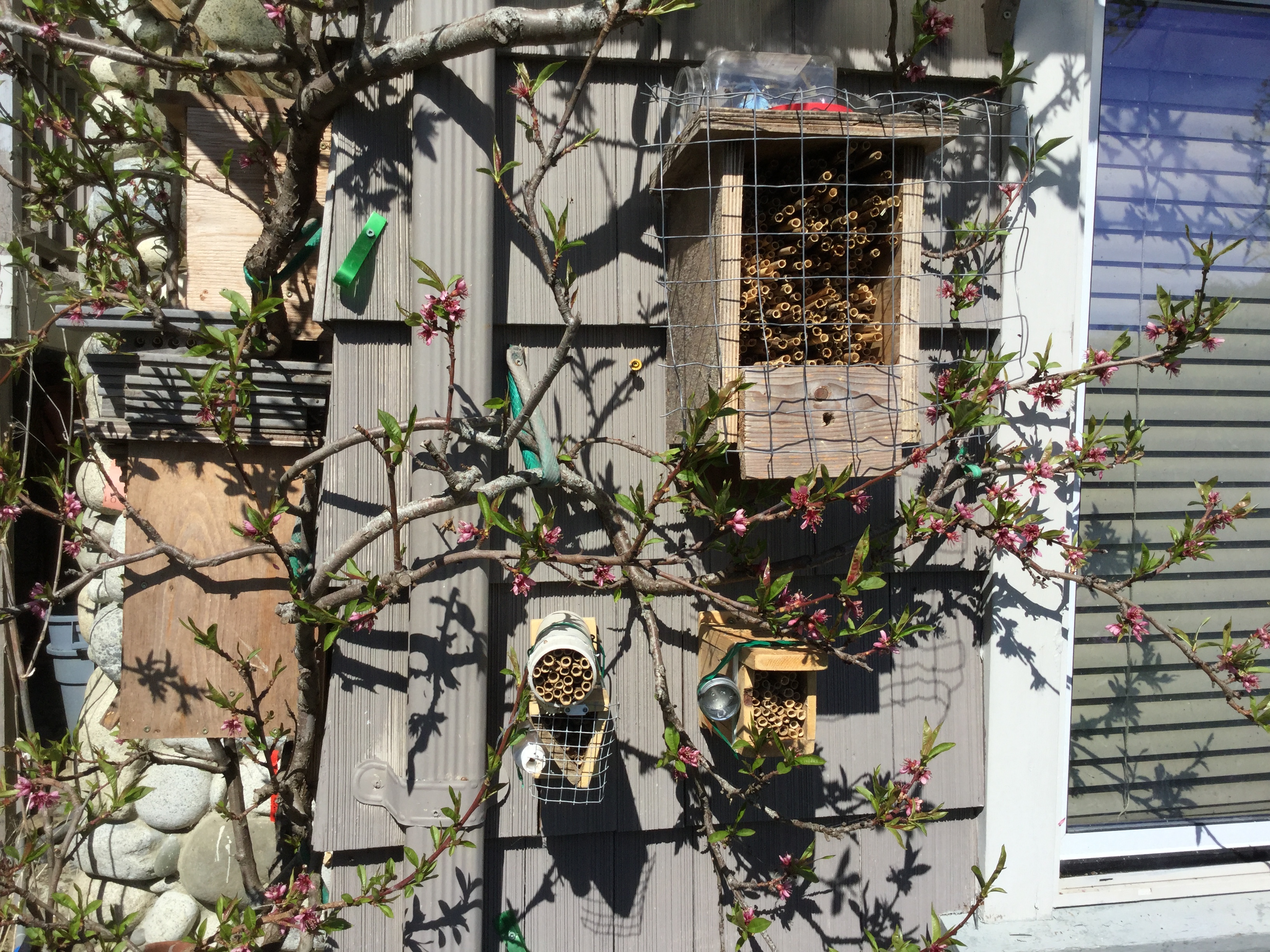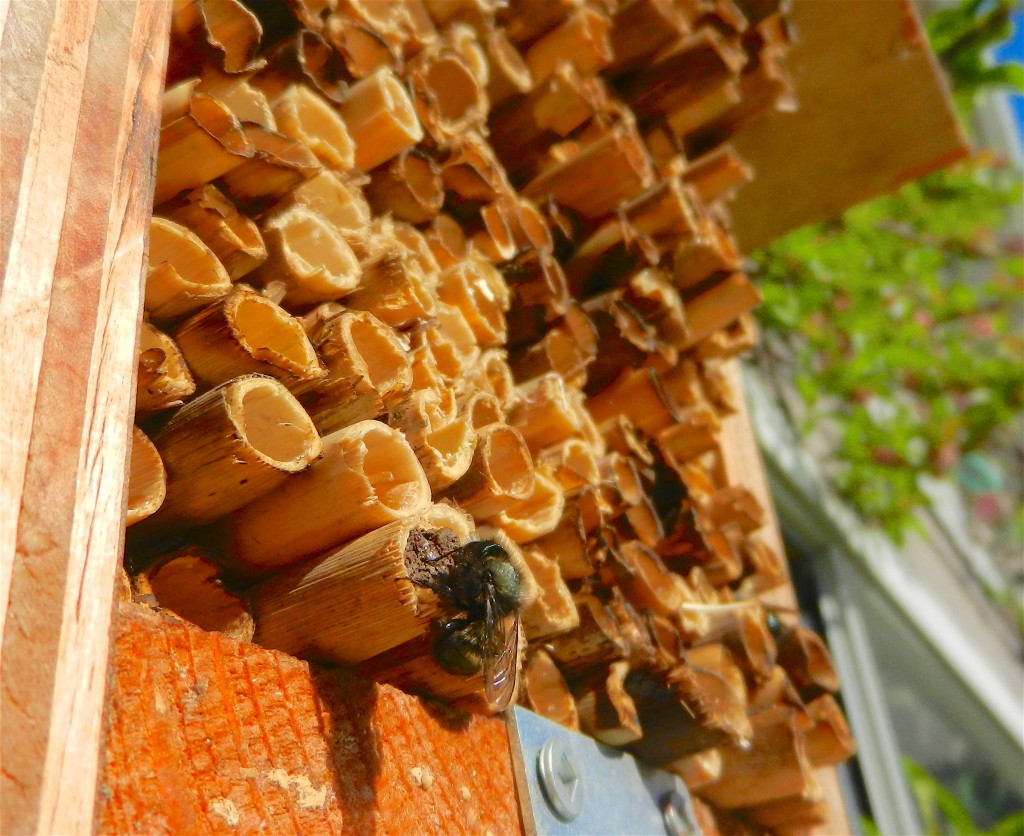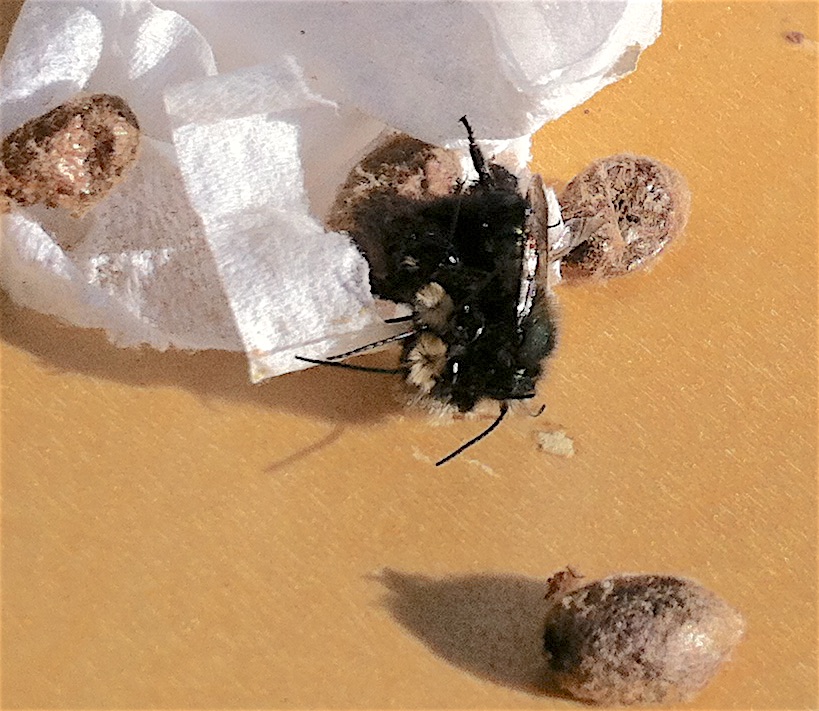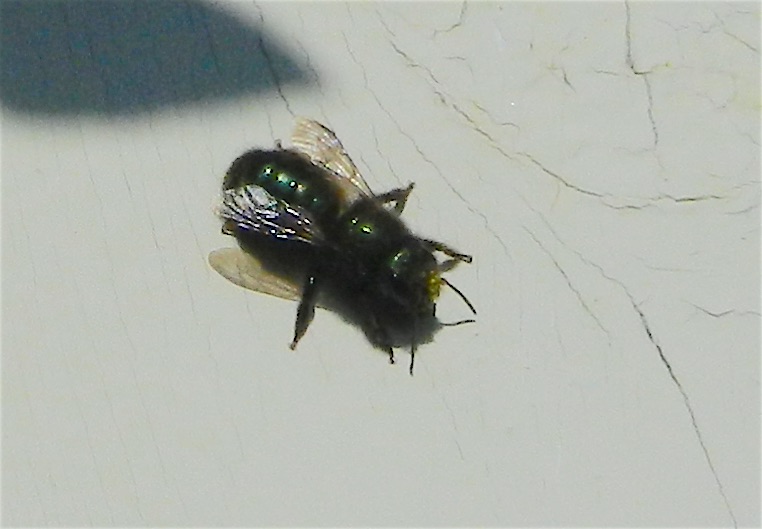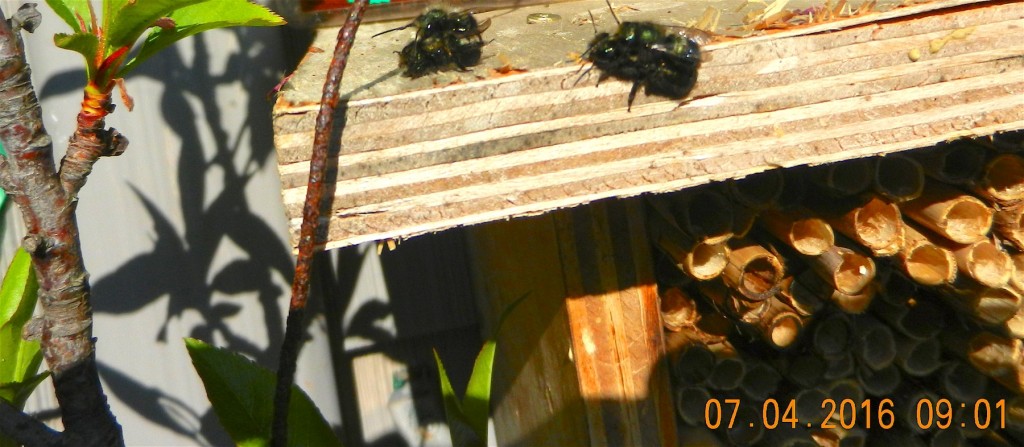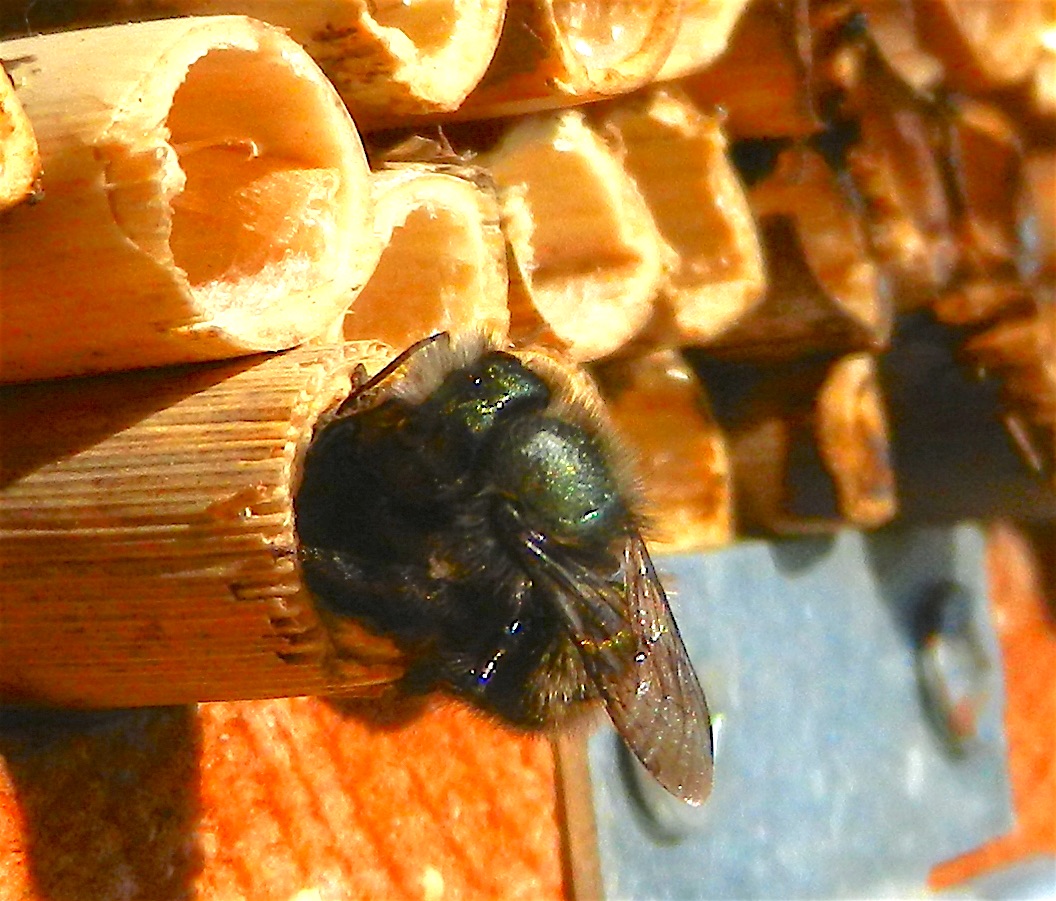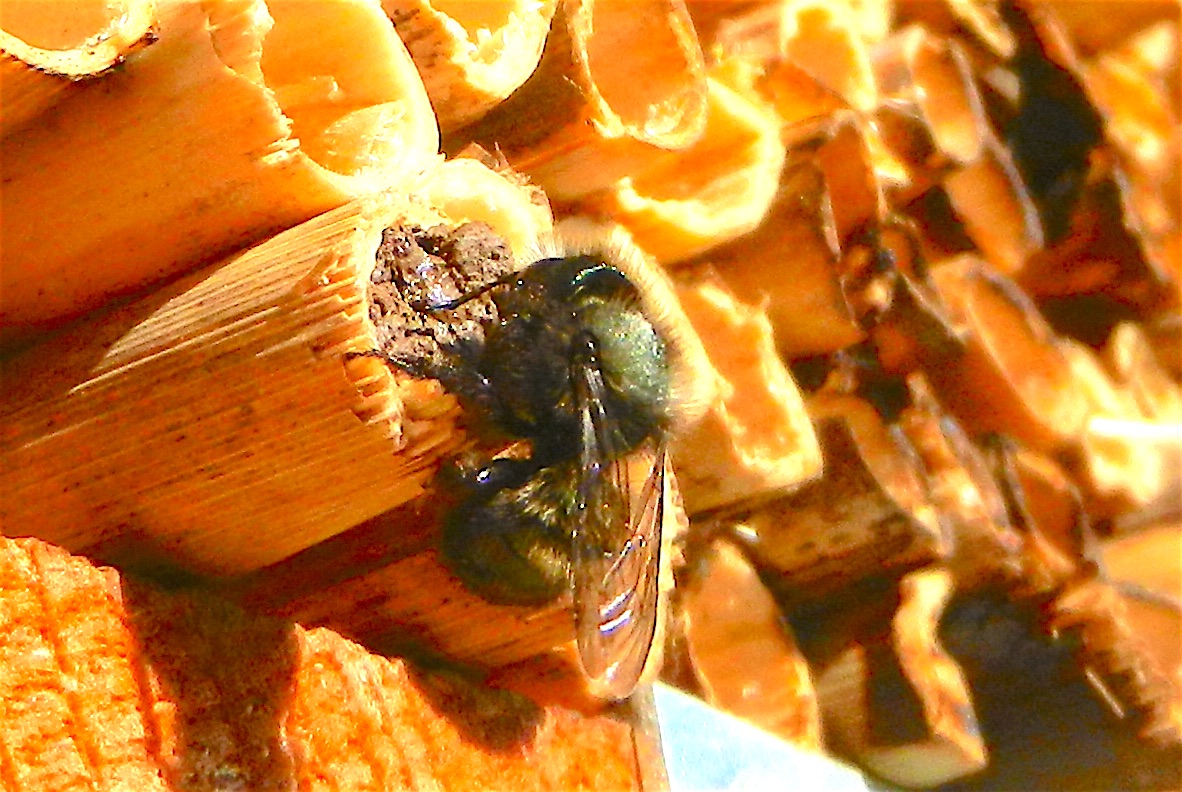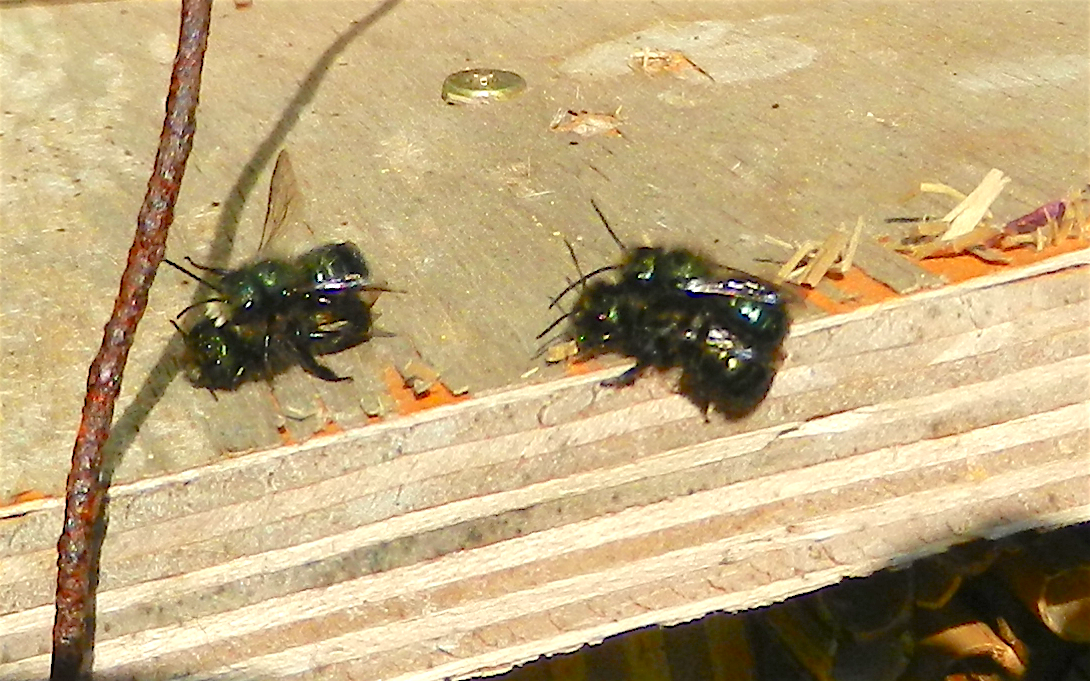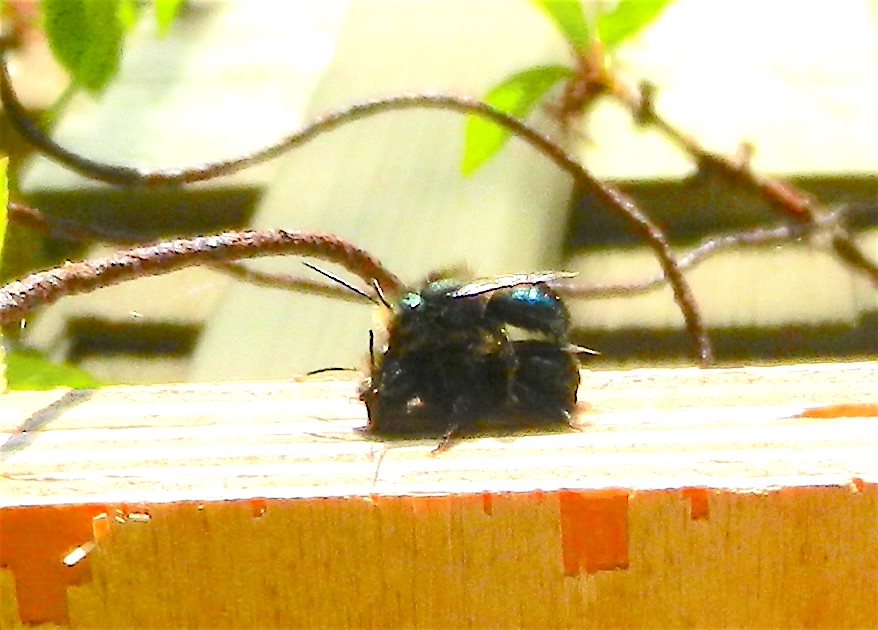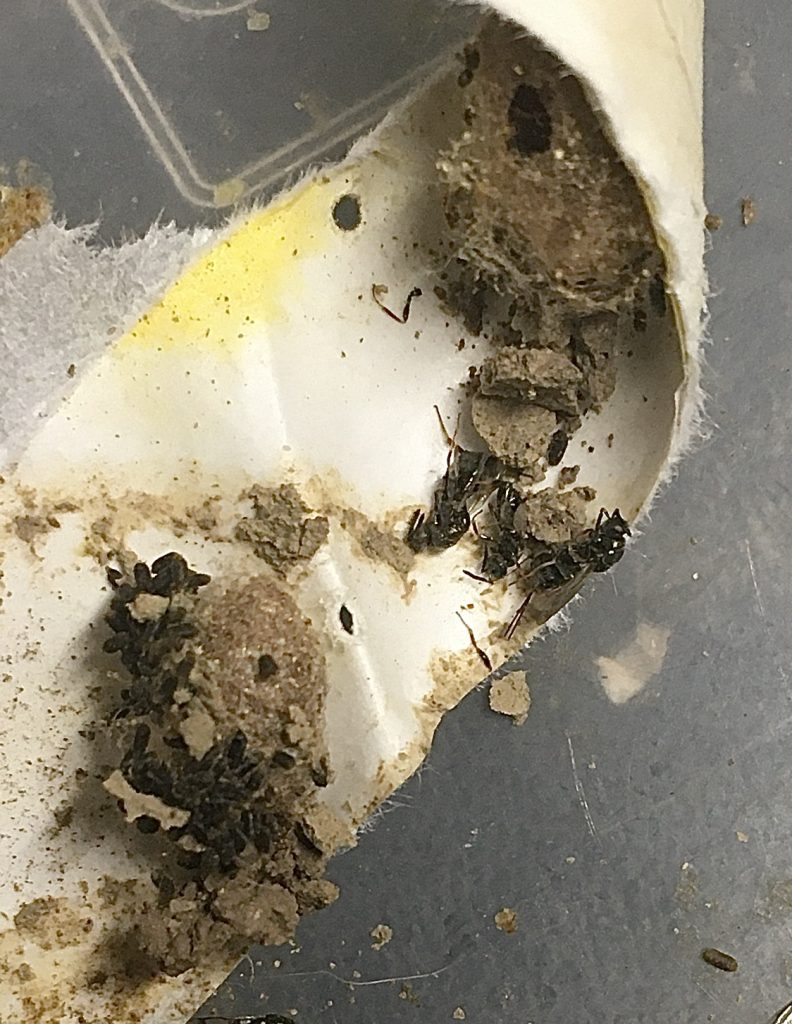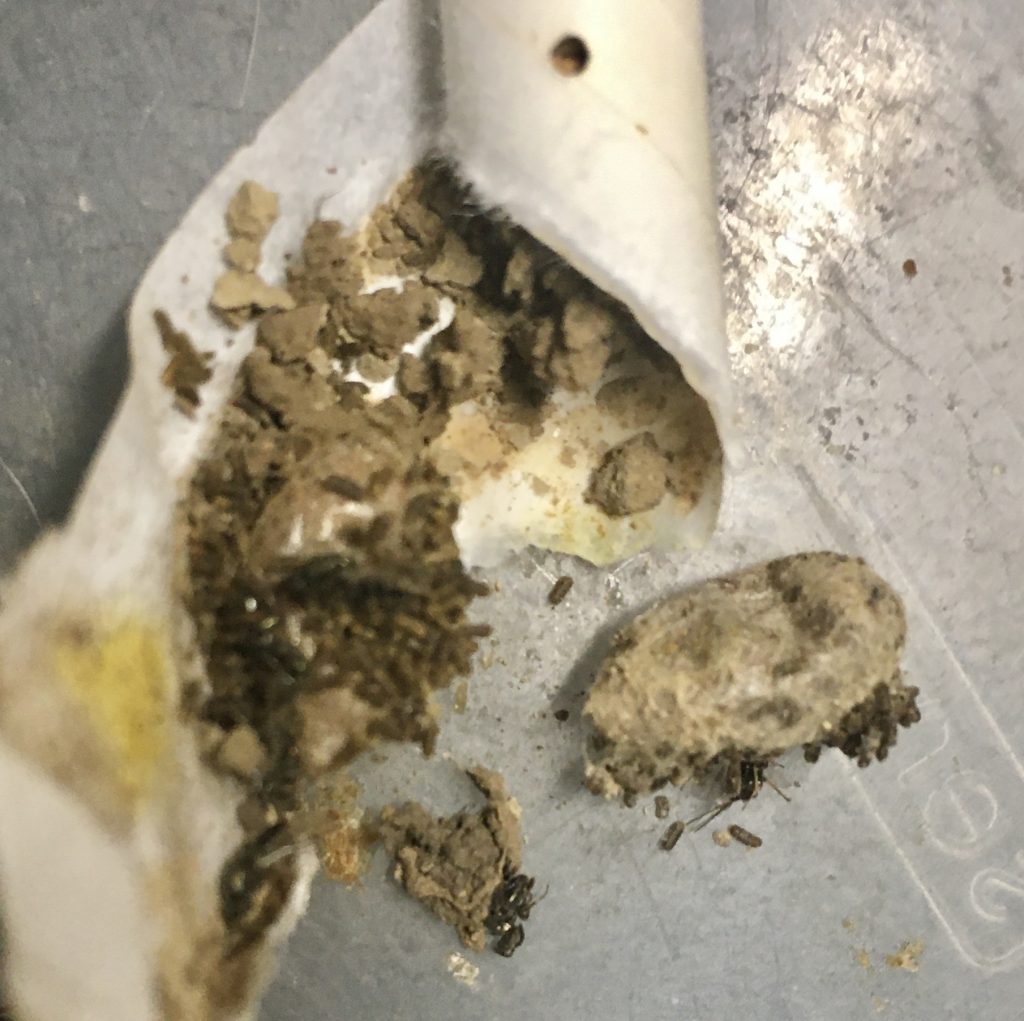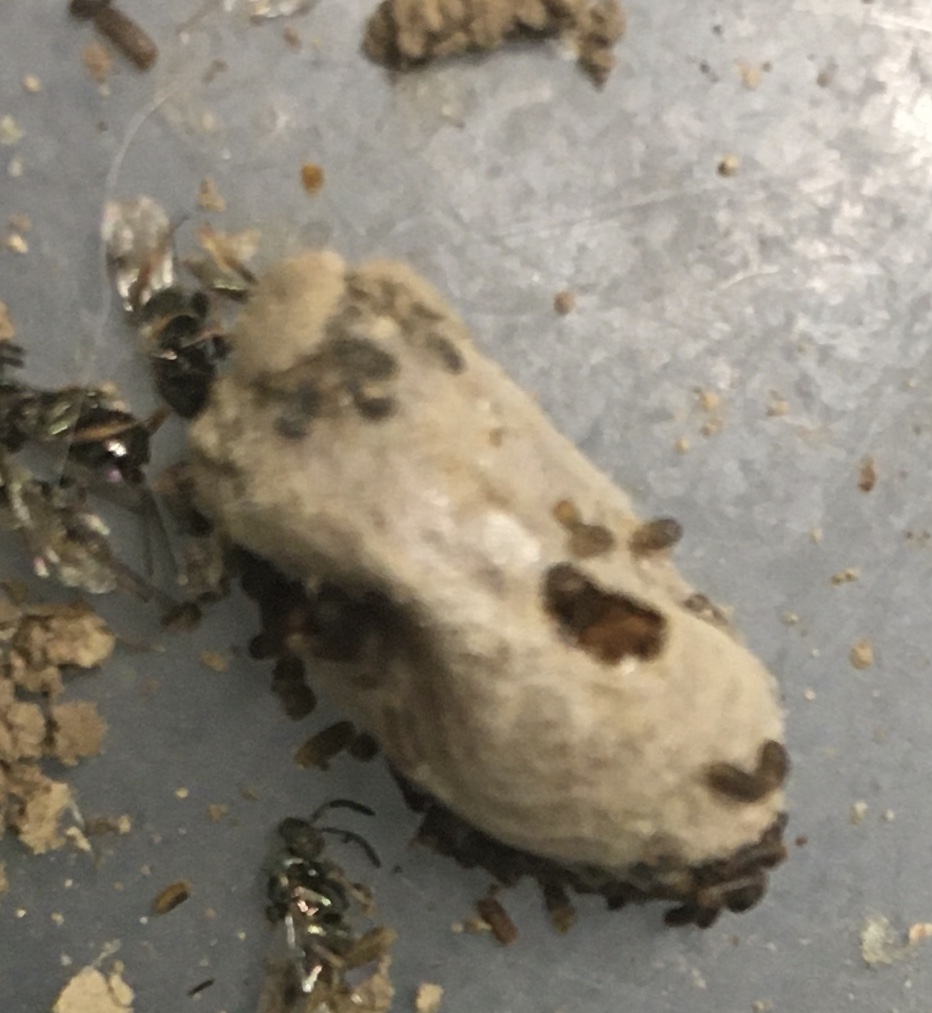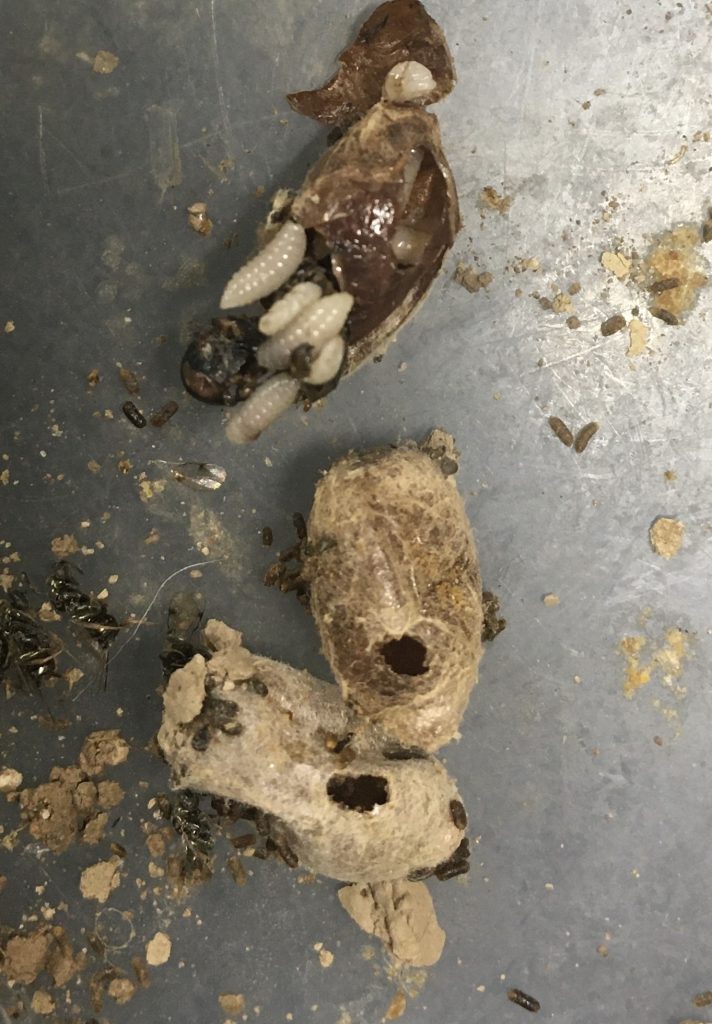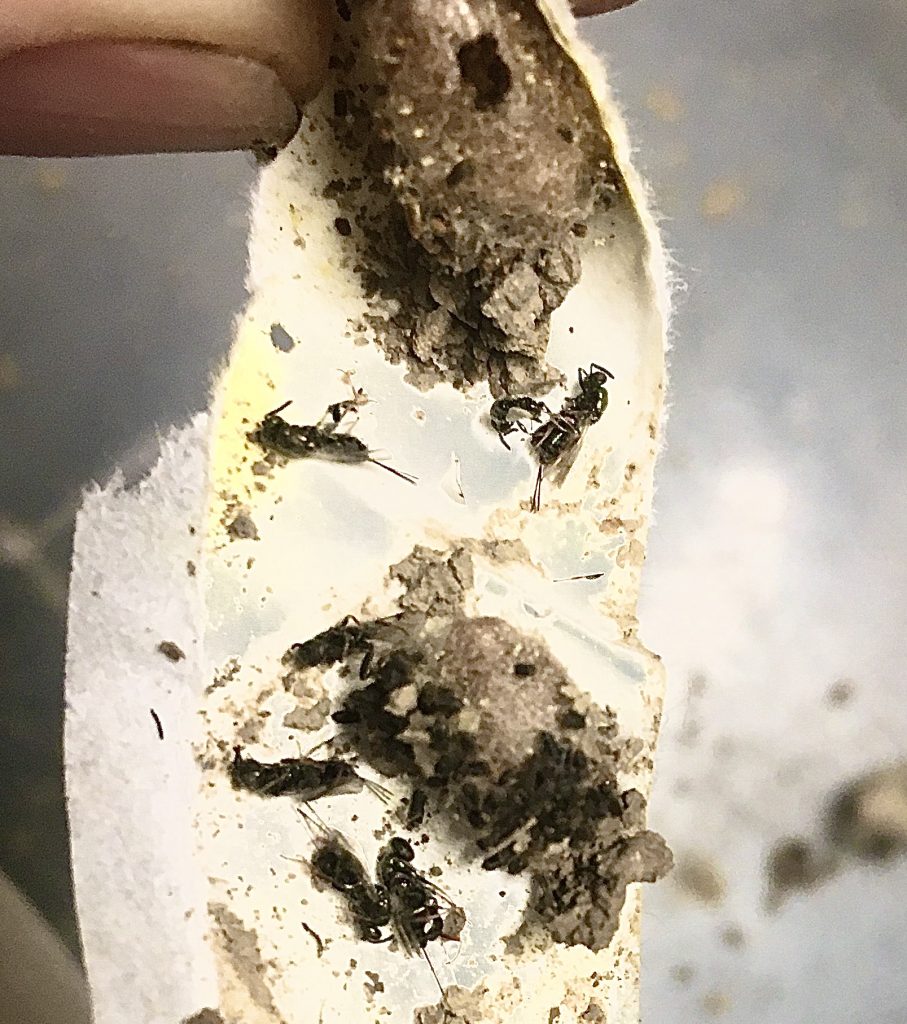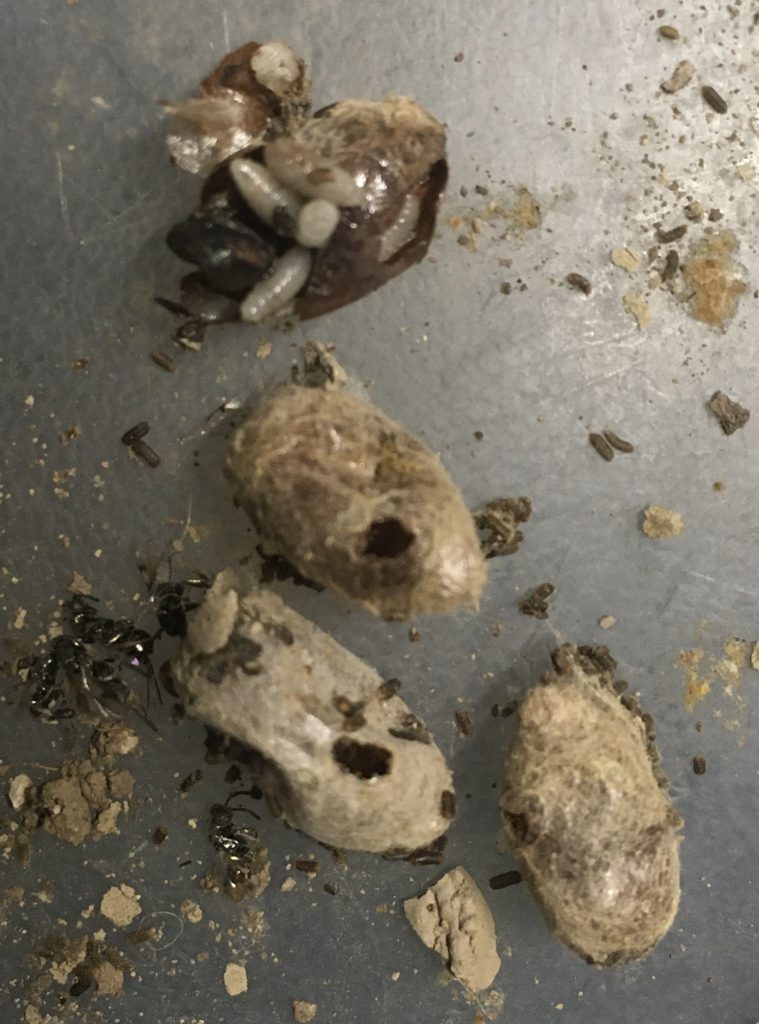ARCHIVAL: This post has been re-dated from 2016 in order to position it closer in the blog to Mason Bee Information
I had a report recently from a mason bee enthusiast telling me that his mason bee colony had been attacked by rats and most of the cocoons had been taken. These images show what happened. One thing I note in the pictures is that the house wqas on a fence with a platform in front of the bank of tubes. It is best to have nothing that birds or rodents can stand on, and that might have prevented this type of predation. If one is concerned at this time of year, it would be a good idea to gently fasten a fine mesh wire screen to the opening of the box, or since the activity of the bees is probably finished, moe the house to a cooler safe location — gently because you want to be sure that the bee eggs have been secured into the food matrix.
Tag: mason bees
Making the best of a bad situation
So you have gone out and bought or have been given a Costco bee house, shaped like a pretty alpine bungalow . Only problem is, their design is contrary to all the best practises of mason bee housing.
See the previous post I did on this here:
However, all is not lost. You can rehabilitate the house so that it has a better chance of working .
Steps to follow:
1. Remove all the short bamboo tubes which are glued in .. Just get a screwdriver and pliars and pry them out.
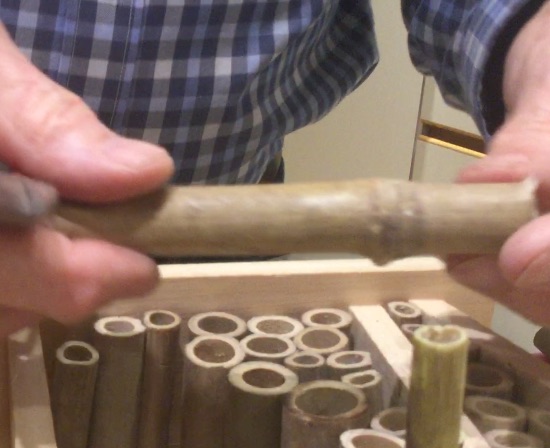
2. Reject the ones with nodes halfway down the tube which allows only a few inches to be useful to the bees. However if you have a drill, you could drill out these tubes.
3. The following diagrams show how you can split the tubes with an exacto blade and then tape them back up. This will allow you to remove the cocoons for cleaning at the end of the season and prevent a deadly buildup of parasitic mites.
4. In the tubes which have too large an opening,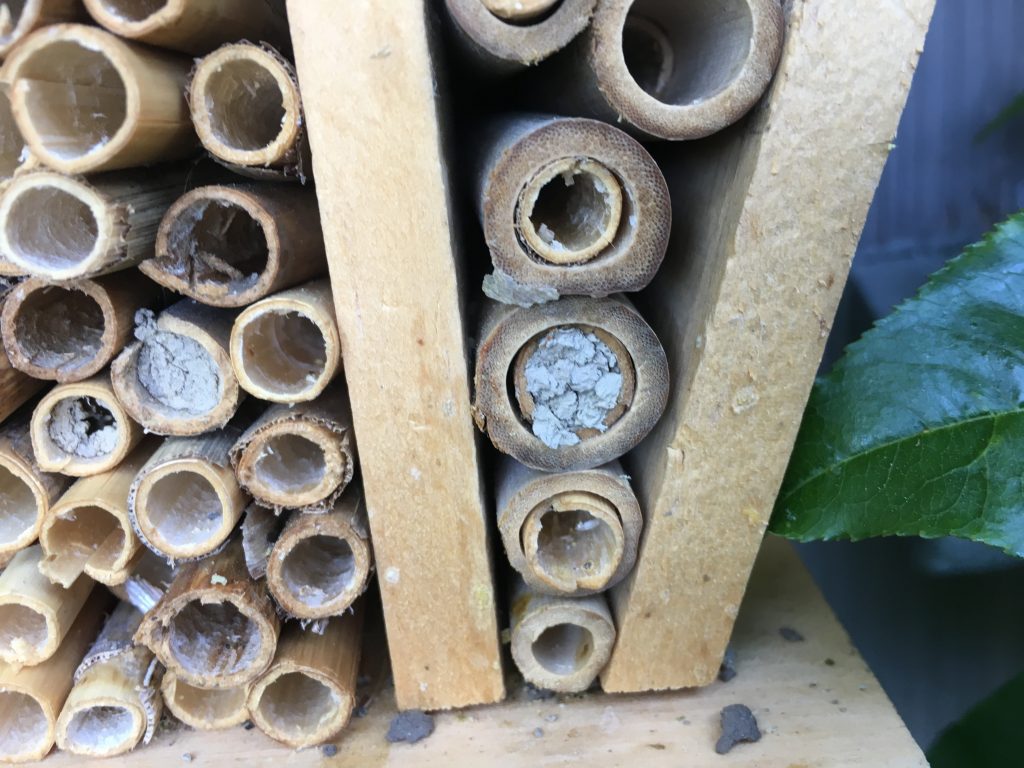 insert tubes of either phragmites reed, cardboard or rolled paper tubes so that these can be extracted at the end of the season to recover the cocoons.
insert tubes of either phragmites reed, cardboard or rolled paper tubes so that these can be extracted at the end of the season to recover the cocoons.
5. Open-ended tubes should have the back end sealed.. I used a glue-gun to do this.
Destroy Empty Mason Bee Cocoons several weeks later..
A few weeks after your mason bee cocoons have hatched, remove the empty cocoons and any that have not opened and destroy them. In some of the unopened ones you might find the tiny larva of the parasitic mono wasp, referenced here on an earlier post.
Why Cleaning Mason Bee tubes after November is Important
NOTE: I have updated this 2016 post in order to make it appear closer to the other mason bee information
Today I came across two unopened reed tubes which I had forgotten in the refrigerator so the cocoons had not hatched out. The image below shows why it is important to clean your tubes out in the winter and not leave them until late spring.
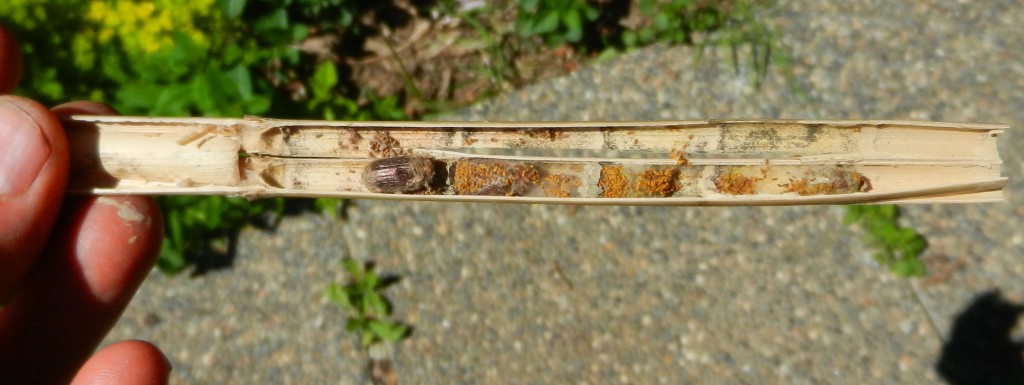
If people leave mason bee homes out unattended from year to year, the parasite population expands . They wouldn’t be so successful in the wild where mason bee nests are more dispersed in holes in wood or under tree bark. . When we provide homes for them however, along with increasing the bee population, we are also multiplying the success of the parasites. So if we are going to encourage bee populations, it is our responsibility to attend to the cocoons in the fall or winter to be sure they are not contaminated with a new generation of mites.
Mason bee eggs
I was cleaning out some phragmites tubes which had not been looked after from last year in a friend’s yard and I assumed that since many of the tubes had penetrated mud plugs (usually a sign of parasitic wasps) then they would be empty. To my surprise, in this one tube I had interrupted a current viable set of eggs deposited on the pollen, and since it was a rainy day, the female was still in the end of the tube. I had not seen the egg at such an early stage before , so i took advantage of the opportunity having ruined this tube, to at least get some photos. I did salvage the few compartments at the end of the tube which hadn’t opened yet, but when a tube is moved this early, there is always a risk of the eggs becoming detached from the food source.
Mason Bee Nesting Tubes: a Comparison
With a variety of information out on the internet on the best tubes to use for Mason Bee culture, I thought I would report here on some of the trials I have run last season which compared different tubes and nestboxes.
In 2018 I placed Phragmites tubes alongside of the commercially available plastic hinged boxes.
For the question .. does availability of the number of nesting tubes determine the success rate?
In the same location as the samples above , I also had a larger supply of tubes available with the following result.. I haven’t calculated the % of successful tubes here. Note also the dimensions of the box.. I used maximum length Phragmites tubes for this box.
A late Season here for Mason Bees
It has been so cool in the last month here in Metchosin that my mason bees have almost missed the peach and nectarine blooming time.
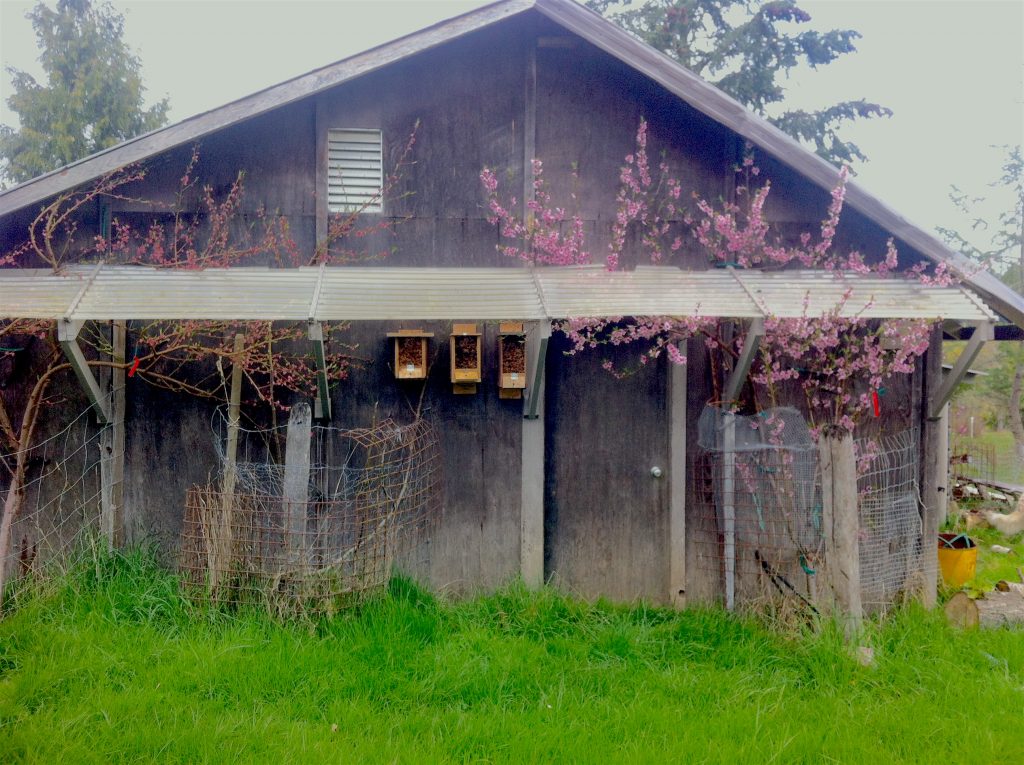
Update–April 15: Today they were the most active i have seen them . I started putting a few cocoons out a week ago, and have warmed up some indoors by just removing their containers from the fridge and then setting the jar out in the daytime when the sun is on them. Anyway a very unusual cold start for the spring.
I have several kinds of houses placed on the southeast corner of our house.
Note, I have re-dated this 2017 post to make it appear with the other mason bee posts.
Mason Bees (Blue Orchard Bees) in action
NOTE: I have updated this 2016 post in order to make it appear closer to the other mason bee information
Some images from this month’s activity of mason bees:
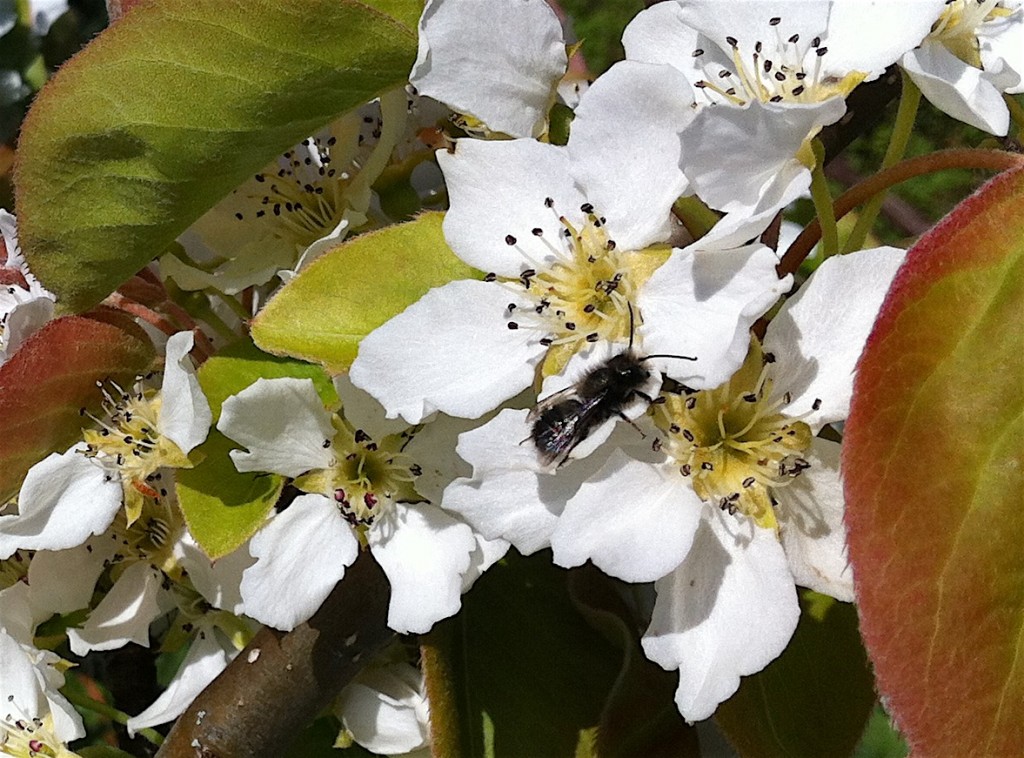
A busy Mason Bee Morning
NOTE: I have updated this 2016 post in order to make it appear closer to the other mason bee information
The warm sun encouraged a lot of activity around the Osmia lignaria boxes today .
Beware of Tubes through which Parasites can Bore
I have experimented for a few years with a kind of plasticized paper tube someone gave to me which were promoted as mason bee home tubes. This year when removing the cocoons from the tubes I noticed small black dots (holes) in two of the tubes which had been mixed in with the phragmites tubes in the nest box . they were suspiciously drilled at very regular intervals, in fact the distance that cocoons are apart.
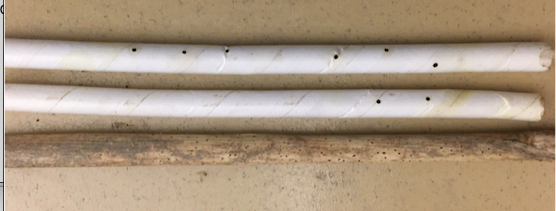
Sure enough, when I opened these tubes, the cocoon which had occupied the spaces beneath the holes did not contain live bees, but instead they were cocoon hulls containing 6-10 live white mono wasp larvae , or hulls with holes and outside of them dead mature mono wasps. Here are a few pictures taken when I was opening the tubes: I had never before seen an example where all cocoons in the same tube had been parasitised like this .
Phragmites reed grass tubes are resistant to the penetration by wasps, so thats one reason they are considered to be superior .
(See https://masonbeesforsale.com/choosing-nesting-materials/) . QUOTE: ” pros: Phragmite Reeds are by far our top choice in nesting materials! They are the best option for several reasons,
1- Size/Shape-Reed tubes naturally vary in size, bees also vary in size and preferences so most bees will find a size they like to nest in. Each tube is cut between nodes so there is a natural back wall. Solitary bees prefer a fully enclosed space to nest in.
2-Protection-They are pest resistant. Mites and parasites aren’t able to burrow through the sides/backs of the tubes.
3-Waterproof– Water will not soften or ruin the tubes. phragmite reeds will naturally wick away moisture. This also decreases the risk of mold, fungus and mildew affecting the bees.
4-Sustainable-Each reed is hand cut to the ideal length (approx. 6inches) from natural sources. Cutting reeds is more environmentally friendly than the burning that usually takes place to get rid of the reeds.
5-Easy Sorting– At the end of the season the reed tubes can easily be split in half. Bees can easily be sorted without damaging the cacoons.
cons:
1- Disposable-Reeds need to be replaced after each season, this requires purchasing new tubes. Luckily they are affordable.
2- Predators– Squirrels and Raccoons are sometimes able to get the tubes out of the bee house if not packed tightly enough. Placing some chicken wire over the front of the bee house and packing the reed tubes tightly in the house will prevent predators from getting your bees. “
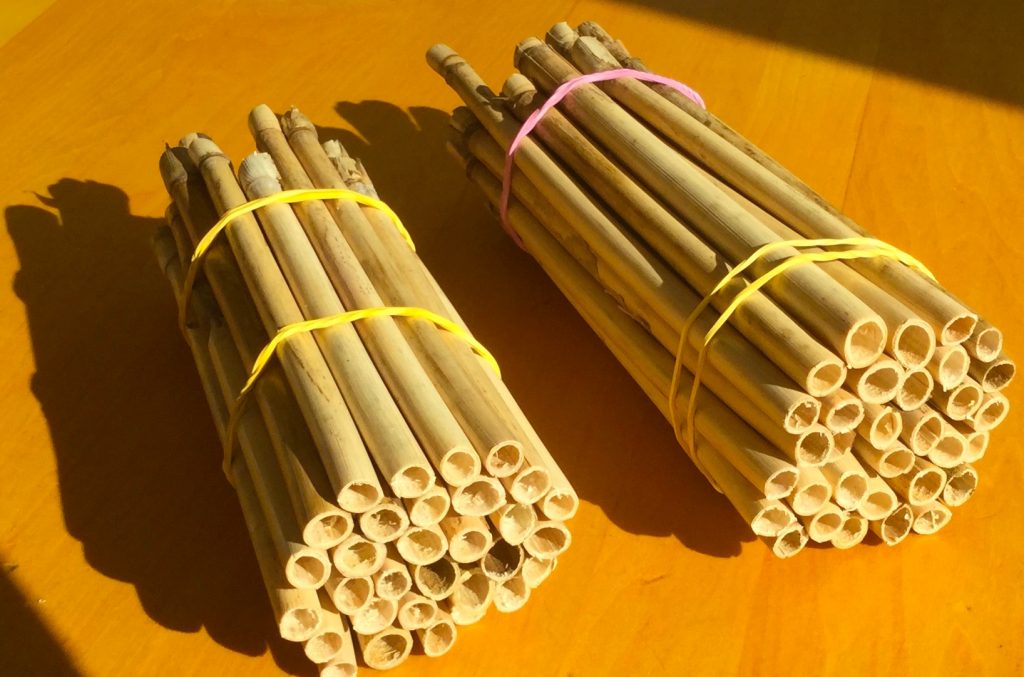
here are some links for various species of parasitic wasp
chalcid wasp predator video: https://www.youtube.com/watch?v=hL6uWSc6rK0
